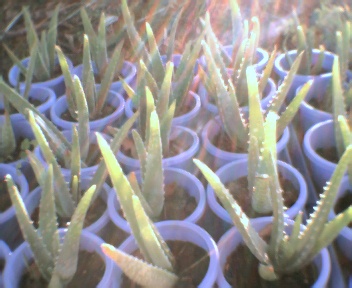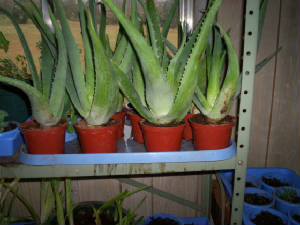|
|
 |
FREE Aloe Plants
Order Here
Aloe vera (syn. Aloe Barbadensis Miller) is
a species of Aloe, native to northern Africa. It is a stemless or very short-stemmed succulent plant growing 80to100 cm tall,
spreading by offsets and root sprouts. The leaves are lanceolate, thick and fleshy, green to grey-green, with a serrated margin.
The flowers are produced on a spike up to 90 cm tall, each flower pendulous, with a yellow tubular corolla 2to3 cm long.
|
 |
|
1 free aloe plant + S/H
| Aloe plants |

|
| Free |
|
 |
 |
|
|
Aloe vera is relatively easy to care for in cultivation in frost-free climates. The species requires well-drained
sandy potting soil in moderate light such as the sun. It may not be consumed naturally. If planted in pot or other containers
ensure sufficient drainage with drainage holes.The use of a good quality commercial potting mix to which extra perlite, granite
grit, or coarse sand are added is recommended. Alternatively, pre-packaged 'cacti and succulent mixes' may also be used. Potted
plants should be allowed to completely dry prior to re-watering. During winter, A. vera may become dormant, during which little
moisture is required. In areas that receive frost or snow the species is best kept indoors or in heated glasshouses. |
|
|
 |
Shipping and handling is extra. The aloe plants are carefully packaged using bubble wrap
and foam peanuts.
Aloe vera has a long history of cultivation throughout the drier tropical and subtropical regions of the
world, both as an ornamental plant and for herbal medicine. For its herbal and medicinal uses, many of which are shared with
related species.
| POTTED Aloe Vera Plant. LONG FAT 12 INCH LEAVES, 4 |

|
| Click here to see more. |
Click here to see more aloes for sale.
|
 |
|
|
|
|
|
Contact me: freealoeplant@yahoo.com
Aloes have a shallow, spreading root system, so when it is time to plant, propagate, or repot choose a wide
planter, rather than a deep one. Use a planter with a drainage hole, or provide a 1-2 inch layer of gravel in the bottom of
the pot to ensure adequate drainage. I find terra-cotta pots are perfect for aloe because they don't retain the extra moisture
that could damage the plant, but, if you are careful not to over water any planter will do. When you pot your aloe offshoots,
or the main plant, use regular potting soil with a extra perlite, granite grit, or coarse sand added. You may also use a packaged
'cacti mix' soil. I have had success with a composted ‘cow manure’ product. Dampen the soil before potting. The
plant won’t require more water for a couple of weeks. Then pierce the soil with a fork, breaking up the hard surface,
down to about two inches. This allows the soil to better absorb the water. Water lightly until it comes out of dormancy in
the spring. Fertilize yearly, in the spring with a dilute (half strength). Aloes are propagated by removing the offsets which
are produced around the base of mature plants, when they are a couple inches tall (or larger). I usually let them get 4 to
6 inches. Aloe plants love bright sun, but will do fairly well in medium light as well. Allow the soil to dry between watering
and water less in the winter than in the warm months. They like being pot bound in my experience, and may be divided each
spring or before if you have a lot of baby plants in the pot. The aloe is a succulent plant, with leaves that can hold water
for long periods at a time. Too much water can rot the plant, and it would take the most severe drought to dry it out. The
plant's only other enemy is cold. It will do quite well next to a window with even minimal light, but it prefers bright, indirect
lighting.
An aloe plant is a welcome friend in the kitchen. Potting aloe is a great children's project by the way. The
plants are easy to handle, and hardy enough for little hands to replant.
|
|
|
 |

